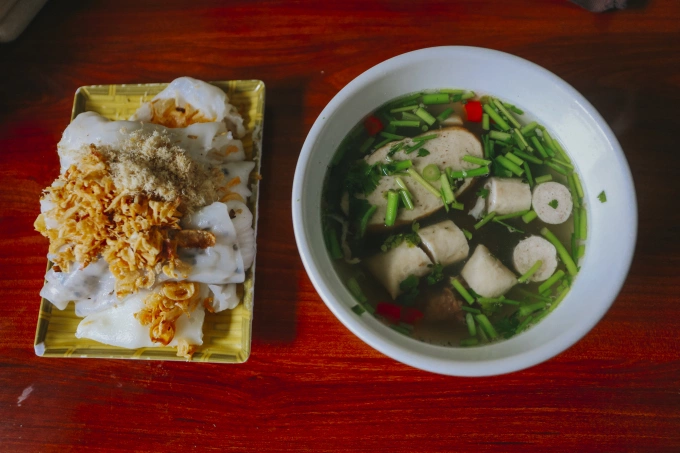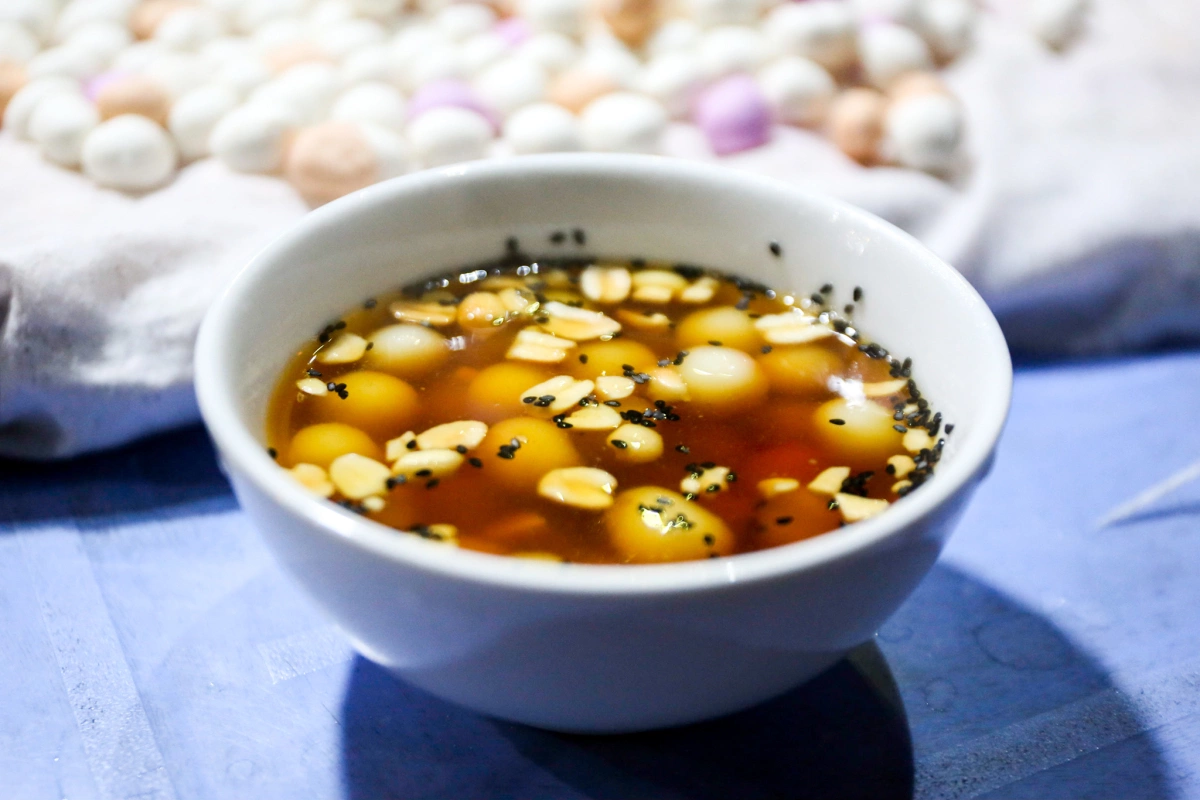
Meo Vac District shares its borders with Ha Giang Province's Dong Van District and Yen Minh Town, as well as with Bao Lam District in Cao Bang Province and the Chinese frontier. It's about 398 kilometers away from Hanoi.
Along with Dong Van, Meo Vac has some of the most renowned tourist destinations in Ha Giang. The picturesque Hanh Phuc (Happiness) Road, also known as National Highway 4C, stretches 200 kilometers and passes through Meo Vac District.
Travelers can visit Meo Vac at any time of the year, as each season has its own unique charm. During spring, the region comes alive with the vibrant blooms of cherry, plum, and mustard flowers. Summer offers pleasant weather, making it an ideal time for adventurous activities. From October to December, the landscape is adorned with buckwheat flowers in full bloom.
Nho Que River
The Nho Que River originates from the Nghiem Son mountain area in Yunnan Province, China. It flows through Dong Van and Meo Vac before eventually merging with the Gam River at Ly Bon Commune, Bao Lam District, Cao Bang Province.
It stretches for 192 kilometers, with 46 kilometers of it in Vietnam, creating strong currents as it winds through layers of rugged rocks. The section near Tu San Alley and Ma Pi Leng Pass in Meo Vac offers gentle, picturesque views of the river meandering along the rocky mountains.
The river was recognized as a Vietnamese Scenic Monument by the Ministry of Culture, Sports, and Tourism in 2009. It is one of the country's unique geological tectonic valleys.
For visitors seeking immersive experiences amidst the scenery, there are opportunities for boating, kayaking and stand-up paddleboarding (SUP) along the Nho Que River. The winding journey down to the boat station and back typically takes around an hour.

The boat dock at the Nho Que River offers visitors the opportunity to savor a 360-degree view of the natural surroundings. Photo by VnExpress/Ngoc Thanh
- Motorboat service price: VND120,000 (US$4.90) per adult, VND60,000 per child.
- Kayak and SUP: VND100,000 per person.
It's advisable to contact in advance to confirm if boats are operational during your visit, as availability may vary depending on the time of your arrival.
Ma Pi Leng Pass
Ma Pi Leng Pass is often referred to as the "king of passes" in Vietnam’s northwest region. It is situated in Meo Vac’s Pa Vi and Pai Lung communes, as well as Ta Lung Commune in Dong Van District.

This 20-kilometer-long pass, located at an altitude of 1,200 meters, connects Ha Giang City with Dong Van and Meo Vac Districts. From the pass’s summit, visitors can enjoy a panoramic view of the rocky plateau, featuring steep cliffs on one side and the abyss of the Nho Que River on the other.
Tu San Canyon

The turquoise waters of the Nho Que River flow through Tu San. Photo by VnExpress/Ngoc Thanh
Tu San Canyon sits at the base of Ma Pi Leng, adjacent to the Nho Que River. The close proximity of these two features, combined with the river’s vibrant green color, creates a majestic scene.
To reach Tu San Canyon, visitors can take a boat or canoe ride for about 20 minutes from the Nho Que River’s upstream wharf.
In the past, prior to the construction of hydroelectric dams on the Nho Que River, only a few individuals dared to approach the vertical canyon. Thanks to the development of hydroelectric projects along the river and the subsequent calming of the river's flow, opportunities arose for people to safely transport tourists to the base of the cliffs by boat.
Khau Vai Love Market
The Khau Vai Love Market is an annual event that takes place on the 27th day of the third month in the lunar calendar. This market, which is over a century old, is in Khau Vai Village, Khau Vai Commune, about 180 kilometers away from Ha Giang City. Unlike traditional markets, this gathering is a place for people to reunite after periods of separation.
What distinguishes this event is that couples attend together, with wives seeking out their former partners and husbands doing the same, all in a spirit of mutual respect and without jealousy or frustration.
However, in recent years, the Khau Vai Love Market has become more commercialized and has started to lose its original rustic charm and meaning. It now also sells various types of goods like other markets.
When dining in Meo Vac and other localities in Ha Giang, you can savor a variety of typical dishes from the province, including:
Steamed rice rolls

Ha Giang-style rice rolls are made with rice flour, ground pork, wood ear mushrooms, pork bones, pork rolls, and spices. The rice flour is soaked, mixed with spices, and steamed. It's then filled with pork and stir-fried wood ear mushrooms, rolled, and cut into pieces. Fried shallots and coriander are added on top. Unlike other regions, these rice rolls are served with a savory pork bone broth instead of fish sauce.
Au tau porridge

A bowl of au tau porridge is adorned with tender pork legs and minced meat, giving it a yellow hue. Photo by VnExpress/Xuan Phuong
Au tau porridge featuring au tau, a local tree with roots that are naturally poisonous but are processed to make them safe to eat. The roots are soaked in rice water for 10 hours and then simmered for several more hours to remove toxins, making them tender.
Thang co
Thang co is a traditional Ha Giang dish, often enjoyed during Tet holidays and available at local markets. Thang co is made from the meat and offal of horses or buffaloes.

It has a distinctive aroma that entices adventurous eaters but can be challenging for those unaccustomed to it. Nowadays, many restaurants offer variations of thang co to cater to the tastes of tourists, deviating from its traditional flavor profile.
Men men
In the rocky plateau of Ha Giang, where rice cultivation is challenging, corn rice, known as men men, serves as the primary staple for the H'Mong people.
Originally, men men was a simple daily meal for the locals, but over time, it gained popularity at markets as a means of sharing their culinary culture with visitors. To prepare men men, corn is dried and undergoes a series of steps, including pounding, residue removal, and steaming. Men men carries the delightful aroma of corn, and when enjoyed, it can be paired with broth for added flavor.
Buckwheat cakes

Named after a typical flower in Ha Giang, the cake is made from buckwheat flower seeds with high nutritional value. Buckwheat seeds are ground, then kneaded into dough and shaped into flat, round cakes, more than a hand in diameter. After being shaped, the cake will be steamed and grilled on a charcoal stove. Having a mildly sweet taste, buckwheat cakes are best eaten when hot.
Thang den
Thang den is a treat made from sticky rice and green beans soaked in apricot sugar water. The rice is soaked overnight, then ground into flour. This flour is then placed in a cloth bag and suspended to air dry. Once the dough reaches a thick and smooth consistency, it is removed from the bag and shaped into cakes.

These round cakes come in different sizes and a range of vibrant colors. Once shaped, the cakes are boiled and then transferred to a bowl, where they are generously soaked in sugar water. The sugar water is usually a blend of sugar, coconut milk, warm ginger-infused water, and is topped with sesame seeds and peanuts for added flavor and texture.
Chung gu cake
Chung gu cake is a specialty of Ha Giang, featuring the vibrant green hue of the wrapping leaves and the deep purple color of black rice. Unlike the larger square traditional chung cake, this cake is compact and fits in the palm of your hand.
The name " chung gu" has several explanations, with many locals believing that its shape symbolizes a woman carrying a basket on her back while harvesting rice and corn in the fields.

To make this cake, dong leaves are used to wrap it. Sticky rice is evenly spread on the leaves and then filled with beans and lean pork belly, along with a blend of spices.
Once the dong leaves are folded to create the cake's shape, it is secured with twine and boiled in a pot for approximately 8-10 hours. This slow cooking process results in sticky, fragrant amaranth rice and tender green beans complemented by flavorful pork.
Five-color sticky rice
The sticky rice features vibrant shades of red, yellow, blue, purple, and white, representing the five elements: metal, wood, water, fire, and earth. This stunning array of colors is achieved by using fruits, roots, and plant leaves. The process involves soaking glutinous rice in water for 6-8 hours and then dividing it into five portions. Except for the original white part, each segment is dyed using natural food coloring agents and then steamed to perfection.

For dining options, you can consider the following restaurants recommended by the travel website TripAdvisor: Thanh Phuong Restaurant, May Co Restaurant, Hoang Dung Restaurant, Ngoc Lan Restaurant, Quyet Hang Restaurant, and Mr. Hung Italian Restaurant & Bar Wine Meo Vac (offering Western cuisine).
Accommodations in Meo Vac offer a diverse range of options, catering to various preferences and budgets. Visitors can find motels, hotels, and homestays, with prices ranging from VND250,000 to VND1.5 million ($10 to $61) for a double-bed room.

Homestay Auberge de Meovac (Chung Pua) provides a rustic and authentic ambiance. Photo courtesy of Homestay Auberge de Meovac
If you're looking for a more budget-friendly option, dormitory-style accommodations typically cost between VND80,000 to VND200,000 per night.
In recent years, homestays in Ha Giang, especially in Meo Vac, have experienced significant growth. These accommodations have invested in facilities and landscapes, allowing guests to immerse in the local way of life, making them a favorite choice among tourists.
Visitors can consider staying at Meovac H'mong Ecolodge, Auberge de Meovac (Chong Pua), Meo Vac Clay House, Lo Lo Homestay & Cafe Meo Vac, and Ma Pi Leng Ecolodge.
Adventure enthusiasts can opt for camping on the white cliffs along Ma Pi Leng Pass, offering spectacular views of the Nho Que River. To reach this spot, drive along Ma Pi Leng Pass, then head onto Ma Pi Leng B road for about 3 kilometers, followed by a trek of about 2 kilometers. For safety, it's advisable to contact local tour guides when planning this excursion.
To reach Meo Vac, visitors will need to cover a distance of over 150 kilometers from Ha Giang City, and approximately 30 kilometers from Dong Van Town. The most common route from the city involves driving along Highway 4C, passing through Quan Ba and Yen Minh districts before arriving in Meo Vac.
Alternatively, some routes take travelers through National Highway 34 and then National Highway 4C, while others pass through National Highway 4C and then Provincial Highway 176. Be noted that as the road is smaller, travel time can be extended.
Navigating the rugged terrain of the rocky plateau can be challenging, given its numerous mountain passes, it's essential for visitors to exercise caution while driving. Alternatively, hiring a local driver is a viable option.
Story by Tam Anh - Phuc Trinh